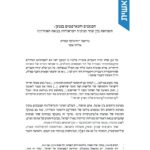This study (some 10,500 words, in Hebrew) is a comparative research of two Israeli pafan movements from the last centurt: the Canaanites and the Neopagans. Some surprising similarities, as well as salient differences are revealed, while focusing on questions of land, Identity, politics, gender, and more. The article ends with a table that summarizes the comparison.
Abstract
In the past century, two movements have glorified pagan mythology in the Land of Israel – the Canaanites, who first formed in the 1940s, and the Neopagans, who have been active since the late 20th century. Both movements opposed the conventional form of “Judaism” in Israel, while reviving and appropriating ancient traditions. The current comparative study examines the similarities and differences between these two countermovements. Their differences lie in the nature of their organization and activity, as well as their ideologies and values. While the Canaanites operated within an ideological and publication-oriented dimension, emphasizing politics of a combative-oppositional character, the Neopagans offer ritualistic lifestyle and practices, which highlight an affinity to nature and a positive inclusive approach. In addition, the Canaanites’ nationalistic spirit contrasts the Neopagans’ universalism, and, accordingly, the former have revived Canaanite mythology, while the latter combines traditions from different cultures.
Authors
Marianna Ruah-Midbar Shapiro
Elijahu Eshed
Links
To download English abstract click here.
For the article’s page on the journal’s Hebrew website click here.
For the volume’s page (Reshit volume 6 – 2022) on the journal’s Hebrew website – click here.
For the journal’s (Hebrew) homepage – click here.
Year
2022
Language
Hebrew
Academic/Non-academic
Academic item
Bibliographical citation
Ruah-Midbar Shapiro, Marianna, and Elijahu Eshed, “Canaanites and Neopagans in Canaan: A Comparison between Two Israeli Movements over the past Century”, Reshit – Studies in Judaism 6 (2022): 25-56. [Hebrew]











